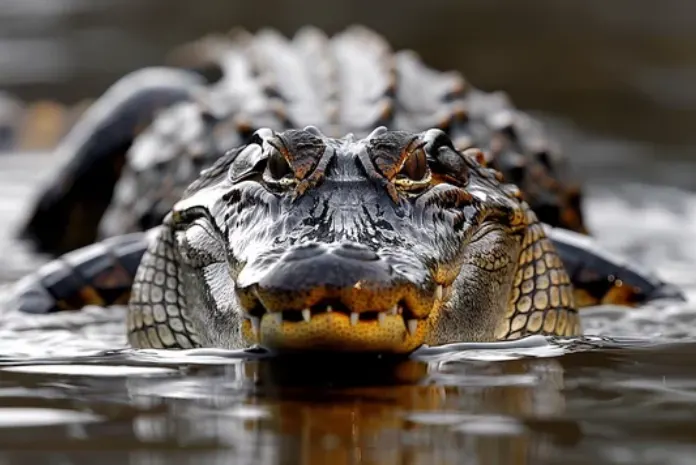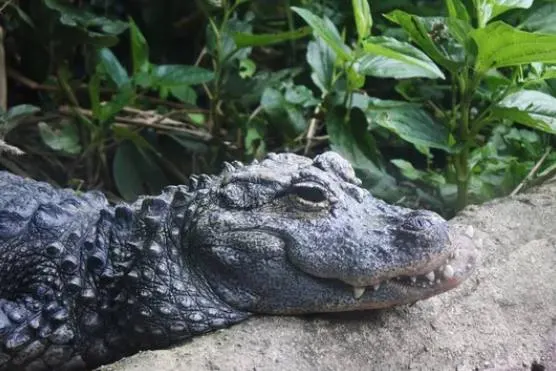The Chinese alligator (Alligator sinensis) is a remarkable species with a unique place in the reptile world. Native to China, this alligator is not only notable for its distinctive physical features but also for its critically endangered status. In this detailed overview, we will explore the Chinese alligator’s scientific classification, physical characteristics, behavior, habitat, diet, conservation status, and more.

Table of Contents
Scientific Classification
The Chinese alligator belongs to the following scientific classification:
- Kingdom: Animalia
- Phylum: Chordata
- Class: Reptilia
- Order: Crocodilia
- Family: Alligatoridae
- Genus: Alligator
- Scientific Name: Alligator sinensis
This classification places the Chinese alligator within the broader group of crocodilians, which includes alligators, crocodiles, and caimans. Its scientific name, Alligator sinensis, reflects its origin, with “sinensis” indicating its Chinese roots.
Physical Characteristics
The Chinese alligator is significantly smaller than its American cousin. Adults typically measure between 4.59 and 7 feet in length and weigh between 80 and 100 pounds. Unlike American alligators, which can exceed 11 feet, the Chinese alligator remains relatively petite.
Key Physical Features:
- Coloration: Adults are generally gray or black, while hatchlings are lighter with speckled patterns.
- Skin Type: The Chinese alligator is covered with bony plates called osteoderms, even on its belly. This armor-like skin provides added protection.
- Teeth: It possesses up to 80 teeth at any given time, which are continuously replaced as they are lost.
- Snout: The alligator’s snout is somewhat upturned, a feature that distinguishes it from other alligators.
- Feet: The alligator has five toes on each foot, and unlike many other alligators, its feet are not webbed.
Behavior and Reproduction
Chinese alligators exhibit a range of fascinating behaviors. During the colder months, they enter a state of brumation, a reptilian form of hibernation. This period allows them to conserve energy while temperatures are low. In warmer months, they bask in the sun to regulate their body temperature and hunt during the night to avoid human activity.
Reproductive Behavior:
- Mating Season: The mating season occurs during the rainy season in June. Males and females use vocalizations and physical displays to attract each other.
- Nest Building: After mating, the female constructs a nest made of vegetation and mud near her burrow. She lays between 10 and 40 eggs, which are incubated by the heat generated from decomposing vegetation.
- Hatchlings: Upon hatching, the female carries the hatchlings to water and protects them diligently.
Habitat and Distribution
The Chinese alligator is endemic to the Yangtze River basin in China. Historically, its range extended farther, but habitat loss has significantly reduced its distribution. Today, it is confined to only a few counties within this region.
Habitat Features:
- Preferred Environments: The alligator inhabits subtropical wetlands, rivers, streams, lakes, ponds, and swamps.
- Adaptations: It builds extensive burrows with multiple chambers, some including indoor swimming pools. These burrows provide shelter and protection.
Diet and Feeding
As an opportunistic carnivore, the Chinese alligator preys on a variety of smaller animals. Its diet includes:
- Small Mammals: Such as rats and other rodents.
- Birds: Water birds like ducks.
- Aquatic Life: Fish, snails, crustaceans, and amphibians.
- Invertebrates: Young alligators particularly consume insects and other small invertebrates.
Conservation Status
The Chinese alligator is classified as Critically Endangered on the IUCN Red List, with an estimated wild population of only 100-150 individuals. The main threats to its survival include:
- Habitat Destruction: Urban development, dam construction, and agricultural expansion have led to significant habitat loss.
- Poaching: The alligator has been hunted for its meat and internal organs, which are believed to have medicinal properties in some cultures.
- Human Encroachment: Pollution and habitat fragmentation have further exacerbated the alligator’s plight.
Conservation Efforts:
- Protected Areas: The Anhui National Nature Reserve for Chinese Alligator was established in 1982 to protect the species and its habitat.
- Captive Breeding: There are approximately 20,000 Chinese alligators in captivity, and organizations such as the St. Augustine Alligator Farm and the Bronx Zoo play crucial roles in breeding and conservation efforts.

Interesting Facts
- Unique Armor: Unlike other alligators, the Chinese alligator is covered with bony plates even on its belly.
- Fossil History: Fossils of the Chinese alligator date back about 3 million years, indicating a long evolutionary history.
- Cultural Significance: Historical references suggest that the Chinese alligator may have inspired the mythological Chinese dragon.
- Teeth Replacement: The alligator can have up to 80 teeth in its mouth at any one time, and these teeth are constantly replaced as they are lost.
The Chinese alligator is a unique and fascinating species with distinctive physical features and behaviors. Despite its intriguing characteristics and historical significance, it faces severe threats that jeopardize its survival. Conservation efforts are crucial to ensuring the future of this remarkable reptile, and understanding its biology and ecology can help us better appreciate and protect this endangered species.
By learning more about the Chinese alligator, we can contribute to its conservation and work towards preserving the rich biodiversity of our planet.
- Enchi Ball Python: A Unique and Stunning Morph of Python regius - March 27, 2025
- Emerald Tree Monitor: The Enigmatic Green Guardian of the Rainforest - March 26, 2025
- The Egyptian Cobra (Naja haje): A Fascinating Serpent - March 25, 2025
